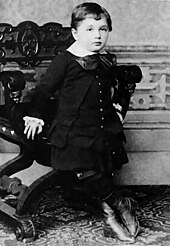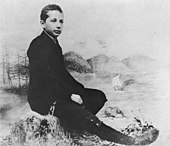User:Trev M/Towards a page-width-sensitive leader
Albert Einstein | |
|---|---|
Elsa Löwenthal, née Einstein, (1919–1936) | |
| Awards |
|
| Signature | |
Albert Einstein (/ˈælbərt ˈaɪnstaɪn/; German: [ˈalbɐt ˈaɪnʃtaɪn] ; 14 March 1879 – 18 April 1955) was a theoretical physicist, philosopher and author who is widely regarded as one of the most influential and best known scientists and intellectuals of all time. He is often regarded as the father of modern physics.[3] He received the 1921 Nobel Prize in Physics "for his services to Theoretical Physics, and especially for his discovery of the law of the photoelectric effect."[4]
His many contributions to physics include the
Einstein published more than 300 scientific and over 150 non-scientific works; he additionally wrote and commentated prolifically on various philosophical and political subjects.[5] His great intelligence and originality has made the word "Einstein" synonymous with genius.[6]
Biography
Early life and education

Albert Einstein was born in

The Einsteins were non-observant
In 1894, his father’s company failed: Direct current (DC) lost the
Einstein applied directly to the
In the same year, Einstein’s future wife, Mileva Marić, also entered the Polytechnic to study mathematics and physics, the only woman in the academic cohort. Over the next few years, Einstein and Marić’s friendship developed into romance. In a letter to her, Einstein called Marić “a creature who is my equal and who is as strong and independent as I am.”[18] Einstein graduated in 1900 from the Polytechnic with a diploma in mathematics and physics;[19] Although historians have debated whether Marić influenced Einstein’s work, the majority of academic historians of science agree that she did not.[20][21][22]
Marriages and children
Patent office
Academic career
Emigration to the United States
Death
Scientific career
Physics in 1900
Thermodynamic fluctuations and statistical physics
Thought experiments and a-priori physical principles
Special relativity
Photons
Quantized atomic vibrations
Adiabatic principle and action-angle variables
Wave-particle duality
Theory of critical opalescence
Zero-point energy
Principle of equivalence
Hole argument and Entwurf theory
General relativity
Cosmology
Modern quantum theory
Bose–Einstein statistics
Energy momentum pseudotensor
Unified field theory
Wormholes
Einstein–Cartan theory
Einstein–Podolsky–Rosen paradox
Equations of motion
Einstein’s controversial beliefs in physics
Collaboration with other scientists
Einstein-de Haas experiment
Schrödinger gas model
Einstein refrigerator
Bohr versus Einstein
Religious views
Political views
Non-scientific legacy
In popular culture
Awards
Honors
See also
Publications
Notes
Further reading
External links
- ^ Hans-Josef, Küpper (2000), Various things about Albert Einstein, einstein-website.de, retrieved 18 July 2009
- ^ http://www.ias.ac.in/currsci/apr25/articles32.htm
- ^ The Nobel Prize in Physics 1921, Nobel Foundation, archived from the original on 5 October 2008, retrieved 6 March 2007
- ^ Paul Arthur Schilpp, editor (1951), Albert Einstein: Philosopher-Scientist, Volume II, New York: Harper and Brothers Publishers (Harper Torchbook edition), pp. 730–746
{{citation}}:|author=has generic name (help) His non-scientific works include: About Zionism: Speeches and Lectures by Professor Albert Einstein (1930), “Why War?” (1933, co-authored by Sigmund Freud), The World As I See It (1934), Out of My Later Years (1950), and a book on science for the general reader, The Evolution of Physics (1938, co-authored by Leopold Infeld). - ^ WordNet for Einstein
- ^ Schilpp (Ed.), P. A. (1979), Albert Einstein – Autobiographical Notes, Open Court Publishing Company, pp. 8–9
- ^ a b c d e Albert Einstein – Biography, Nobel Foundation, retrieved 7 March 2007
- ^ Einstein: the life and times, By Ronald William Clark
- ISBN 3-03823-182-7
- ISBN 0-465-08140-1
- ^ Dudley Herschbach, "Einstein as a Student," Department of Chemistry and Chemical Biology, Harvard University, Cambridge, MA, USA, page 3, web: HarvardChem-Einstein-PDF: Max Talmud visited on Thursdays for six years.
- ^ www.chem.harvard.edu/herschbach/Einstein_Student.pdf Albert’s intellectual growth was strongly fostered at home. His mother, a talented pianist, ensured the children’s musical education. His father regularly read Schiller and Heine aloud to the family. Uncle Jakob challenged Albert with mathematical problems, which he solved with "a deep feeling of happiness."Most remarkable was Max Talmud, a poor Jewish medical student from Poland, "for whom the Jewish community had obtained free meals with the Einstein family." Talmud came on Thursday nights for about six years, and "invested his whole person in examining everything that engaged [Albert’s] interest." Talmud had Albert read and discuss many books with him. These included a series of twenty popular science books that convinced Albert "a lot in the Bible stories could not be true," and a textbook of plane geometry that launched Albert on avid self-study of mathematics, years ahead of the school curriculum. Talmud even had Albert read Kant; as a result Einstein began preaching to his schoolmates about Kant, with "forcefulness"
- ^ Einstein’s greatest intellectual stimulation came from a poor student who dined with his family once a week. It was an old Jewish custom to take in a needy religious scholar to share the Sabbath meal; the Einsteins modified the tradition by hosting instead a medical student on Thursdays. His name was Max Talmud, and he began his weekly visits when he was 21 and Einstein was 10.
- ISBN 9810249853, retrieved 4 March 2007
- ISBN 0-571-17170-2
- ^ Highfield & Carter (1993, pp. 21, 31, 56–57)
- ^ Letter Einstein to Marić on 3 October 1900 (Collected Papers Vol. 1, document 79).
- )
- ^ Alberto A Martínez (April 2004), Arguing about Einstein’s wife, Physics World, retrieved 21 November 2005
- ^ Allen Esterson, Mileva Marić: Einstein’s Wife, retrieved 23 February 2007
- ^ John Stachel, “Albert Einstein and Mileva Maric. A Collaboration That Failed to Develop.” In: Creative Couples in the Sciences, H. M. Pycior et al. (ed) (PDF), retrieved 23 February 2007
